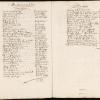I read:
Ariaantje Jans van Dijssel & haar dogter
Jannetje van Straten J.D. op 't hoekje van de Langedijk.
AJvD and her daughter
JvS unmarried woman (jonge dochter, literally: young daughter) on the corner of the Langedijk.
And regarding the age of confession: in the 17th century this was much lower than nowadays: 18 or even 15-16.On the other hand: Ariaantje Jans van Dijssel must have been a lot older, since her daughter did her confession simultaneously.


Anne
zei op dinsdag 11 maart 2025 - 13:46